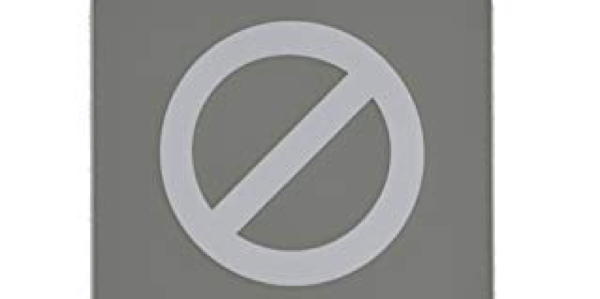
Some artists are challenging me about the concept of grey not being a color. (this is for you, Vince) I get it. As we paint, we have been taught to reach for “grey” to add to our paintings. Typically in my workshops an attendee will ask, “Should I add grey to this area? And I respond with “Which one? There are so many.” And then they are confused for a bit until I show them the following:
I went into my studio space and grabbed as many “grey” sticks as I could find with the goal of finding “grey.” These are all different values (light and dark) and are from different brands, so some are square, some are round, etc. If it clearly had some color, I didn’t pick it.
Here are a few in the drawer – I picked these guys along with some others… trying to find the most “grey” sticks I own.
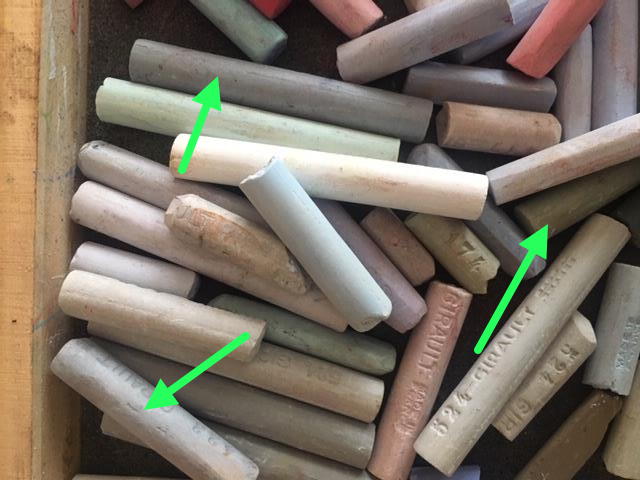
Here are 12 of them lined up on white…
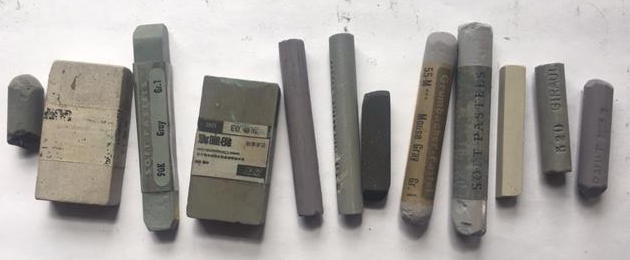
Here they are lined up on black… yes, these are the exact same sticks in the exact same order lined up in the exact same place in front of natural lighting from a window at the exact same time. Cool huh?
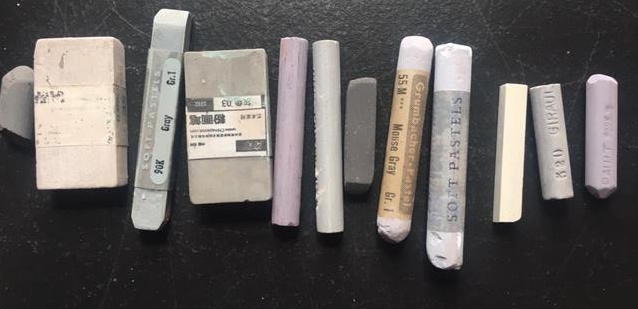
Already you can see them shift between the two backgrounds in value, but more importantly, if you look hard, none of them are without color. And remember, I tried to find sticks that had none. Each of these sticks still has a color identifiable from one of the 12 hues from the color wheel. I dare you to try to find one of these that has no color in it…
This is how I perceive them on my computer. Ask yourself- what is the color here and how is the stick “kicked?”
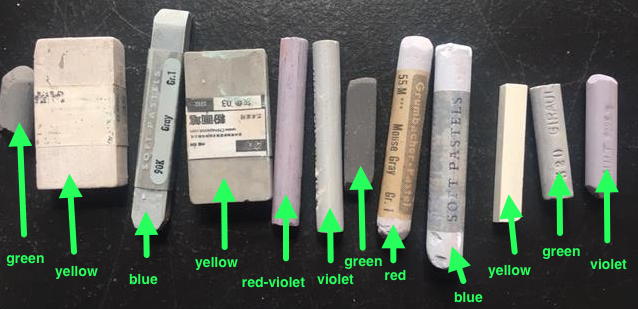
They all fall into one of the 12 color families. Even in this “washed out” low-chroma version, there is no “grey.” Grey is not an independent entity. What may at first appear grey is really a dirty version of blue, violets, red, greens or even yellow. Even when mixed from paint. Although blue tends to be the most common shift to any stick that is seen as “grey,” it is good to know you are actually painting with a color. Painting an orange flower? You can make that orange pop more if you use a low-chroma stick that is blue-based and not orange-based. See how powerful this can be??
So can the colors shift between color families depending on what is around it or what background surrounds it? Yup. (As if color theory weren’t complex enough…) If you remember this pic below from the “Grey is Not a Color” blog, then you can see the same stick changed in apparent hue families as it went across the different colored backgrounds… at the far left it appears almost orange on black, at the far right it appears dark green on lime paper. Yup. Same stick… one stroke across… nature does not have to explain herself.
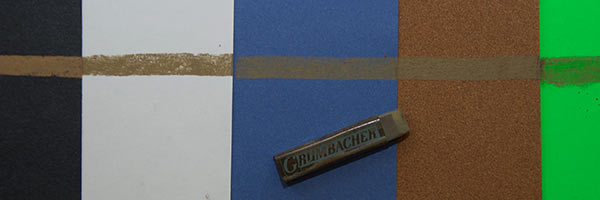
Here they are again below on white- the same photo… notice how some of them have shifted color from my previously labeled photo of them sitting on black…
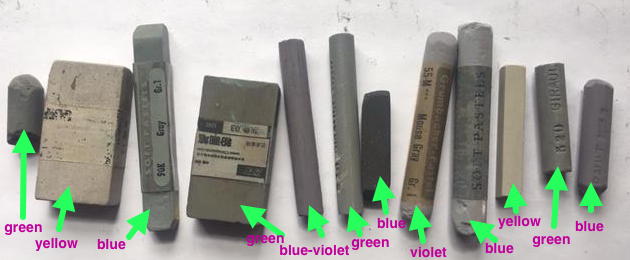
Cool huh?
Color is like energy. It can’t be destroyed. Only evolved into something else. So “grey” or, as I call it, a very low-chroma color, will always have some color dominance in it based on what is around it. Again, it is why I don’t care about “perfectly” sorted color trays.
Color shifts. It is elusive. And it is wonderful.
So yes, the same “grey” can change in apparent color dominance between hue families. But what will not change is whether or not they are inherently a blue-based or yellow based color. Here are my sticks now sorted into yellow or blue-based dominances regardless of color family… This is how I separate them on each side of my Berlin Wall… yellow on the left, blue on the right… (remember- our computer monitors are all slightly different- you may be seeing these a bit differently from me- but this is a good place to begin to ask yourself about the colors).
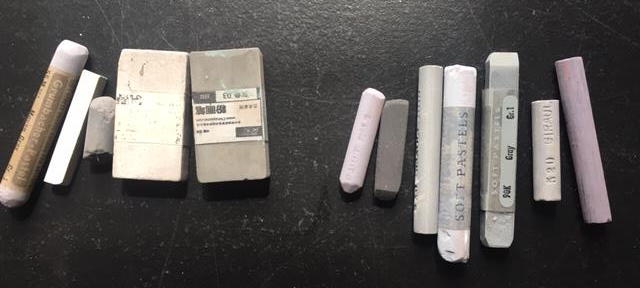
A savvy artist will now start to question how this plays into color temperatures… exactly!
So even the very first header photo above can be dissected into colors… inside a white or black square the “grey colors” will change and shift…
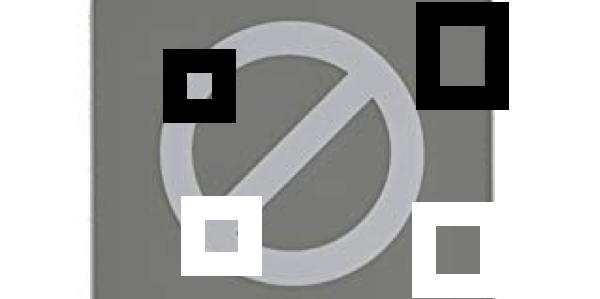
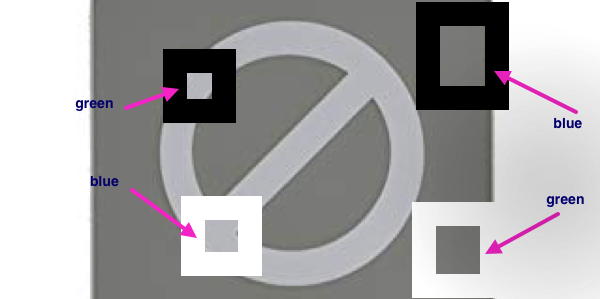
This is how I label them above. Squinting helps to see the colors…
So neutrals do not exist. A “neutralized” version of a color exists, but you can’t eliminate color from a mixture.
In that vein, “Brown” is also not a color… more on that next week…
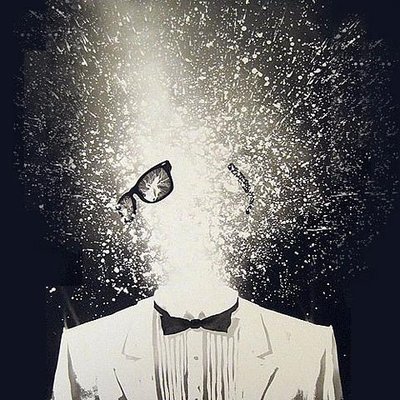

I love it when you talk theory! Which is the grey area right😉
perfect!!!!
Just when I start to understand what you are discussing, and start to get comfortable with it. Study it. Use it. Understand it. You throw another curve ball. Thanks. I needed that. Went looking for part 1. Couldn’t find it.
It was one of the first blog posts I did- I linked it two weeks ago on that blog. I believe if you see it on the site it is April 2017…look for title “grey is not a color” in the older blog posts…..:)
A few odd years ago I purchased a Great American set of “Greys”. I found that I don’t really care for the Great American product, but I was enamored over the colors. Not a grey among them. It kind of started me on a journey to study, (albeit half assed), color. I found that these “greyed” colors made the nice bright colors shine even more so. I have since purchased the Mount Vision set of “Thunderstorm” set. I expected that there would be no actual “greys” but a wonderful set of “greyed” colors. I was not disappointed. Although I prefer other brands, I find the Mount Vision more useful in ways I cannot explain. I think I’m getting to be a snob about pastels. I loved my Rembrandts. They were my backbone set. My go to get the job done pastels. I finished with the softer ones. I’ve all but stopped using them. The ones that I still use, low and behold, are those wonderful greyed ones. Those lavender greys, greens etc. I’ve been expounding on there being a place for all hardness levels of pastels, and still do believe that. But now I am looking at the pigment % as well as the color intensitivity as well.
hehe…you go girl with your Rembrandts! and yes, order a grey set and they look colorful against each other….challenge…find a stick with no color- can’t be done….
I agree with everything you say, except that “Grey is not a color.” Black is a color. True white may NOT be a color, as it is the lack of color, whereas black is the presence of all colors (commonly misunderstood). Back to grey: As you know, the opposing color on the color wheel, when mixed, form grey. As Dan Greene says, “It might be called ‘mud’, if you add in other colors.” But, semantics do not change the physics. If your real point is to demonstrate that colors appear to change when put aside of various other colors, that is certainly true. Side comment: When I explain “white” and “black” to people, I use being in outer space, where you can put your hand in front of your eyes and not see it—that is black! No light. If you look at a welder’s burn, or the moment of eclipse, where you can burn your eye from the intensity of the brightness–that’s white! (The welder’s glass is not clear–it is tinted to protect the eyes from the intensity, not the spark). I explain it this way to students and amateurs to get them to follow how broad nature really is and to expand their visual vocabulary. Or, I’ll grab a piece of “white” paper and lay it on another sheet of “white,” to show the difference in values. I tell them that it really is an extremely light grey, and black is an extremely dark grey. But neither is really white nor black. So, we’ll politely disagree. Call it what you would like to, but the examples you used above may be “bluish grey,” or “greenish grey” by adding yellow, or whatever, but they are colors. They are called other things in different languages. Hope all is well and you’re enjoying Sewickley….Good stuff…Ciao!
sorry Vince, Black is not a color either….it not on the color wheel, so, not a color…..and most blacks fall into the blue hue….challenge- find me an example of a mixture without a color —I will find the color shifts. And mixing color swill still produce not a “grey” but a combination of color that will STILL have a color dominance based on what is around it. White is actually all colors in physics, but us poor artists have to stick with pigment where we use things like titanium white (a pigment) to explain it. Titanium white, by the way, is blue-based! 🙂
fascinating and informative explanation of the gray/grey non-color which is really a color.
yup! it is all color!!! 🙂
Thank you Christine. These latest blogs are just SO helpful.
🙂
Wouldn’t the color temperature be determined by spontaneous contrast to colors surrounding the “grey w color”?
yes definitely. the color itself will still lean toward yellow or blue, but it can change in temperature in regards to what is around it. For example, a light blue surrounded by a dark cobalt blue may kick the lighter blue to feel warm.
I really enjoyed this article and look forward to the next one. My ‘ah ha’ moment a while ago was to think of how I saw colours touched by sun or by shadow. I am not sure this fits perfectly with your discussion but there is a good overall fit.
yes, perfect! there are colors in both light and shadow. no such thing as a “neutral”….